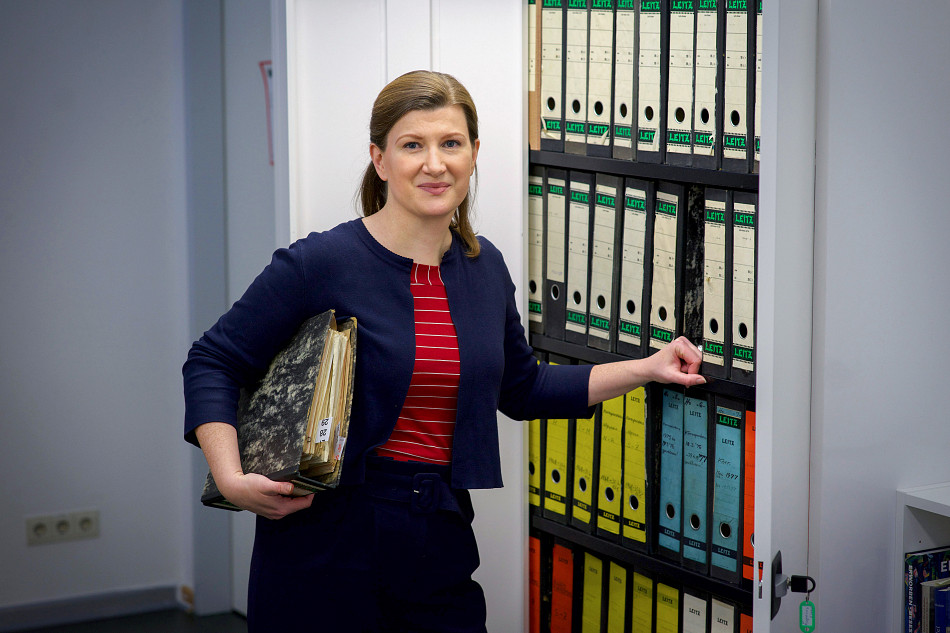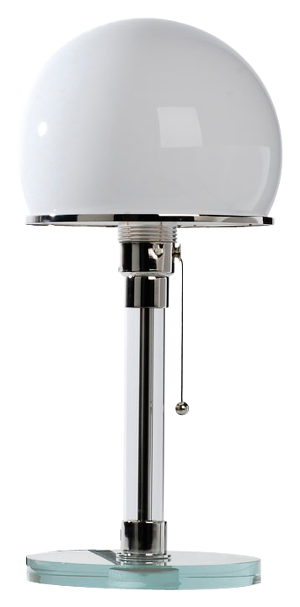
Corinna Rader
Provenance researcher
Corinna, you’ve been conducting provenance research at the Bauhaus-Archiv since 1 April 2020. What exactly does that involve?
Well, let me begin with a definition. Provenance research deals with the origin, history and legal conditions of ownership of artworks and cultural assets. The goal is to establish a chain of ownership with as few gaps as possible – from the artist’s studio to the present owner. I investigate how certain works have found their way into our collection, especially those confiscated from their previous owners by the National Socialists.
Why is this of interest for the Bauhaus-Archiv?
Although the Bauhaus-Archiv was founded in 1960 and couldn’t have purchased any works during the years of National Socialism between 1933 and 1945, the collection does contain numerous items produced at the Bauhaus in Weimar, Dessau and Berlin between 1919 and 1933. The pieces survived the National Socialist regime, so to speak. But in many cases, little is known about their paths of ownership during those years.
It is especially important to remember that at least 200 of the 1,200 members of the Bauhaus were of Jewish descent. That means that they were victims of Nazi persecution, they were forced to flee or were even murdered. We know that at least 14 Bauhaus artists perished in concentration camps. With regard to their works, we must ask ourselves how they found their way into our archive.
What’s more, the artworks of many Bauhäusler were condemned as “degenerate” by the Nazis. If they were displayed at museums, they would have been confiscated in August 1937 as part of the “Degenerate Art” campaign and were likely sold to foreign collectors to procure hard currency. Strictly speaking, so-called “degenerate art” is not considered Nazi-confiscated cultural property, but even these cases are “typical” for our collection and should be documented.
So how do you proceed? As the only provenance researcher here at our archive, do you have to investigate the provenance of the entire collection?
Yes, well … the holdings of Bauhaus-Archiv comprise some one million objects. For one researcher, that would be enough work for more than a lifetime. But I started at the very beginning with Inventory Number 1. Then I examined the first 2,000 inventory numbers, all in chronological order. In the first step, I always look for provenance features on the object – inscriptions, dedications, stickers, numbers and such things. Then I analyse the enormous collection of documentary materials stored here at the archive, and also literature and other databases. And throughout, as I mentioned, I always keep my eye out for works by Jewish artists.
It’s paradoxical, really – at the Bauhaus, worldviews and religion played no role at all. In many cases, I first have to figure out who had a Jewish background or was married to a Jew. To do this, I read biographies. For example, I’m reading one now by Ruth Vallentin (later Cidor-Citroën), titled “From the Bauhaus to Jerusalem”. Vallentin married into a Jewish family and consequently shared the fate of many European Jews. I also learned about the dramatic events in the lives of the Bauhäusler Otti Berger and Friedl Dicker. In this way, the biographies help me gain insight into the artworks.
It sounds like detective work …
Yes, I follow clues like a detective. But that’s just how the scientific process works. Usually there are several clues I can choose to follow. Sometimes I can “solve a case” under an hour, and sometimes it takes six months or longer to come to a verdict. There are estates that are dispersed halfway around the world which makes it difficult to gain access to the sources. But fortunately, I work at an archive, many sources can be found right here because our institution has superbly documented its own history.
Tell us about an object whose provenance you’ve been able to clarify.
For instance, there was the graphic work “Das Hoftor” (The Courtyard Gate) by Gerhard Marcks, which the Bauhaus-Archiv obtained in 1963. I stumbled across it while perusing the inventory book, it was listed among a group of prints that had been purchased from the auction house Klipstein and Kornfeld in Berne. I then located the auction catalogue for this 110th auction in the art library. There I found a comment that one of the copies which had been auctioned off that day bore the stamp of the Kunstverein Jena. Checking in our storerooms, I discovered that our copy indeed bore the stamp. This was an important clue. It turns out the Kunstverein Jena had collected and displayed works by many artists who were later denounced as being “degenerate”. Furthermore, on the reverse, someone had written in large print the number “13955” in blue coloured pencil. This practically makes it a textbook case. This is what we call the “EK” number (short for “Entartete Kunst”, ed.) which was used to register confiscated works designated as “degenerate”.
By consulting the Harry Fischer list, known to be the most comprehensive inventory register of the “Degenerate Art” campaign, I was able to determine that the graphic work was acquired by the Fohns, a collector couple, in a barter transaction. The Fohns, who lived in Italy, offered the Reich Chamber of Culture 25 works from the 19th century in exchange for at least 450 works of “degenerate art”. They continued purchasing works through art traders who had been commissioned to “liquidate” the collection, and so doing, they eventually purchased some 620 works which were delivered to them from former museum holdings in Germany. Among these were some veritable icons of modernism.
A great bargain …
That’s for sure! After the war, the Fohns often described themselves as the rescuers of “degenerate art”. There is some truth in that, but it’s a bit more complicated. They indeed donated 220 pieces to the Bavarian State Painting Collection in 1964. But the remaining two thirds they simply sold for a profit, and that at a time when the prices for modern art began to skyrocket. One of these sales, as we now know, was conducted by the auction house Klipstein and Kornfeld in Berne in 1963, which is how the Marcks’ work entered the collection of the Bauhaus-Archiv.
And what does this provenance mean for the Bauhaus-Archiv?
Marcks’ “Hoftor” wasn’t confiscated as a result of Nazi persecution, that is clear. Legally speaking, the “Law on Confiscation of Products of Degenerate Art” of 31 May 1938 permitted the German Reich to seize works without compensation. And this law remains effective today. The Bauhaus-Archiv is therefore the legitimate owner of Marcks’ “Hoftor”. And yet, such provenance is regarded as a moral blemish. In a case such as this, my concern is mainly to engage in an open and honest discussion about the origin.
So if it’s not always about returning artworks, what exactly is the purpose?
The systematic search for cultural assets seized through Nazi persecution from former Jewish owners, in particular, is a moral obligation. I’m looking at works whose origins most likely have ties to confiscation, but I cannot yet present them here. More is on the way!
Generally speaking, all collection objects benefit from provenance research. A collection piece without provenance is like someone suffering from amnesia whose loss of memory results in a loss of identity. Knowing where something comes from, the path it took to get here, is always beneficial, e.g. for the presentation and education activities at the museum. A beautiful object is aesthetically pleasing, but it leaves a more lasting impression if it has an interesting backstory!
Especially in view of the Jewish Bauhaus members, my work naturally contributes to the culture of remembrance. Even Hans Maria Wingler, the founding director of the Bauhaus-Archiv, investigated the biographies of the Jewish Bauhäusler for which he travelled to Israel and Eastern Europe to conduct research. In that sense, I’m continuing an important task that our founding director began.
Learn more about individual cases of provenance research at the Bauhaus-Archiv!
